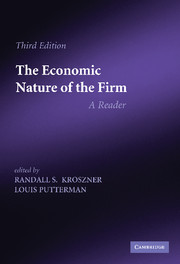Book contents
- Frontmatter
- Contents
- Editors' preface
- Reintroducing The Economic Nature of the Firm
- Part I Within and among firms: the division of labor
- Part II The scope of the firm
- Part III The employment relation, the human factor, and internal organization
- 13 Production, information costs, and economic organization
- 14 Contested exchange: new microfoundations for the political economy of capitalism
- 15 Understanding the employment relation: the analysis of idiosyncratic exchange
- 16 Multitask principal–agent analyses: incentive contracts, asset ownership, and job design
- 17 Work motivation
- 18 Worker participation
- Part IV Finance and the control of the firm
- References
- References
16 - Multitask principal–agent analyses: incentive contracts, asset ownership, and job design
Published online by Cambridge University Press: 05 June 2014
- Frontmatter
- Contents
- Editors' preface
- Reintroducing The Economic Nature of the Firm
- Part I Within and among firms: the division of labor
- Part II The scope of the firm
- Part III The employment relation, the human factor, and internal organization
- 13 Production, information costs, and economic organization
- 14 Contested exchange: new microfoundations for the political economy of capitalism
- 15 Understanding the employment relation: the analysis of idiosyncratic exchange
- 16 Multitask principal–agent analyses: incentive contracts, asset ownership, and job design
- 17 Work motivation
- 18 Worker participation
- Part IV Finance and the control of the firm
- References
- References
Summary
Introduction
In the standard economic treatment of the principal–agent problem, compensation systems serve the dual function of allocating risks and rewarding productive work. A tension between these two functions arises when the agent is risk averse, for providing the agent with effective work incentives often forces him to bear unwanted risk. Existing formal models that have analyzed this tension, however, have produced only limited results. It remains a puzzle for this theory that employment contracts so often specify fixed wages and more generally that incentives within firms appear to be so muted, especially compared to those of the market. Also, the models have remained too intractable to effectively address broader organizational issues such as asset ownership, job design, and allocation of authority.
In this article, we will analyze a principal–agent model that (i) can account for paying fixed wages even when good, objective output measures are available and agents are highly responsive to incentive pay; (ii) can make recommendations and predictions about ownership patterns even when contracts can take full account of all observable variables and court enforcement is perfect; (iii) can explain why employment is sometimes superior to independent contracting even when there are no productive advantages to specific physical or human capital and no financial market imperfections to limit the agent's borrowings; (iv) can explain bureaucratic constraints; and (v) can shed light on how tasks get allocated to different jobs.
- Type
- Chapter
- Information
- The Economic Nature of the FirmA Reader, pp. 232 - 244Publisher: Cambridge University PressPrint publication year: 2009
References
- 8
- Cited by



